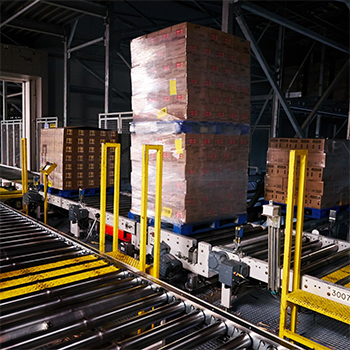With all the trade media coverage of goods-to-person, shuttle-based case handling systems in e-commerce and parcel shipping order fulfillment applications recently, you might think that automated pallet storage with a unit load automated storage and retrieval system (AS/RS) is no longer a popular solution.
That’s not the case with viastore’s customers, however.
Multiple companies, including Americold, the leading global third-party logistics (3PL) provider of temperature-controlled warehousing, and Ukrainian food processing company Myronivsky Hliboproduct have implemented automated pallet storage as a means to handle slow- to medium-moving products.
These crane-based systems are ideal for reserve storage of items destined to replenish automated goods-to-person systems, as well as forward pick zones of manually picked fast-movers.
Additionally, transitioning from manual to automated pallet load handling offers a variety of benefits in warehousing, distribution, fulfillment and shipping applications. Among them are:
Cube maximization: High-density, rack-supported pallet AS/RS systems create dense storage to make full use of a facility’s overhead space. Reaching as high as 148 feet, the cranes accessing the pallets run in aisles as narrow as 41.33 inches. That means more pallets of product - as dense as 10 deep in a channel storage configuration - can be stored in a smaller footprint.
The additional space freed up by an automated pallet storage system can be used to house more products, expand forward picking areas or complement current order fulfillment practices with value-added service offerings.
Inventory accuracy: Directed by advanced software, including a facility’s warehouse management system (WMS) and warehouse control system (WCS), pallet placement within the AS/RS is tracked and monitored. That level of automated control removes the chance of an operator forgetting to scan the pallet license plate number (LPN) to a location.
The tracking also ensures that established inventory cycling practices, such as first-in/first-out (FIFO) or last-in/first-out (LIFO), are consistently followed - preventing waste due to expiration.
Labor savings: Eliminating manual pallet load handling can reduce labor costs by 50% or more. Facilities that rely on workers with forklifts or pallet jacks to transport and maneuver loads of product into and out of racking may face inconsistent labor availability, or have difficulty filling job openings.
Alternately, an AS/RS operates dependably (24/7 if needed) with no human intervention required.
Damage reduction: Automated pallet handling allows a facility to transport loads into and out of the racking without forklifts at a consistent and predictable rate. Removing forklifts cuts the risk of a forklift impact that could cause damage to product, building structures or personnel.
Increased throughput: Manual operations trying to increase their order fulfillment rates often assume that “adding more bodies” to process more orders will produce the boost in throughput they need to keep up with seasonal peaks or promotional demands. In practice, however, that often leads to congestion and a reduction in throughput.
Because unit load AS/RS can handle loads up to 6,600 pounds at drive speeds up to 787 feet-per-minute, and lifting/lowering speeds at 262 feet-per-minute, the system’s productivity can be ramped up to accommodate higher throughput demands with minimal impact on the rest of a facility’s operation.
Related: Switching from a ‘Person-to-Goods’ to an Automated ‘Goods-to-Person’ DC Operation

Article topics
Email Sign Up


















